- Forum
- categories
- Sanitation systems
- Toilets without urine diversion
- Container-based, mobile or bag-based toilets
- The Clam - A compostable chamber pot.
The Clam - A compostable chamber pot.
8521 views
- Billy
-
 Topic Author
Topic Author- interested in productive sanitation
Less- Posts: 9
- Karma: 2
- Likes received: 2
Lets see if I manage to post some photos. The clam shell works nicely to cover a deposit made in a field. No flies. Not the overall solution but better than leaving feces uncovered and could be used by those who like to have a morning chat with the other men (or women) of the community whilst performing their respective bowel functions. Firm feces pressed between shells can be left for a long time if kept in dry places. A sort of manure pack principle. Alright if dry, a major problem if wet!
Don't throw it all away!
Attachments:
-
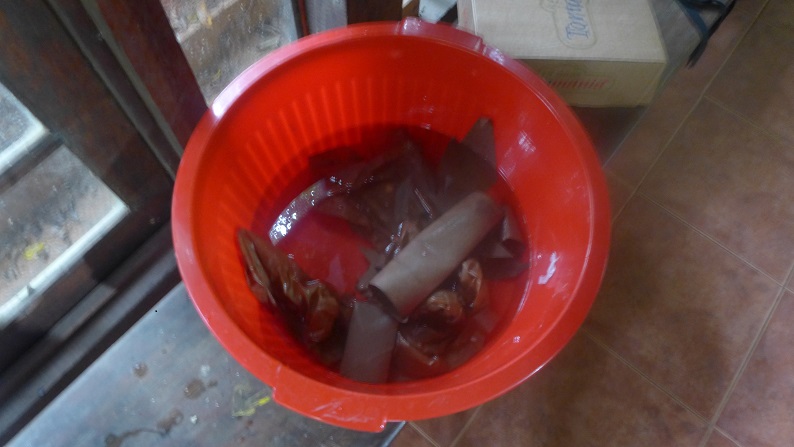 SoakedCardboard.jpg
(Filesize: 102KB)
SoakedCardboard.jpg
(Filesize: 102KB)
-
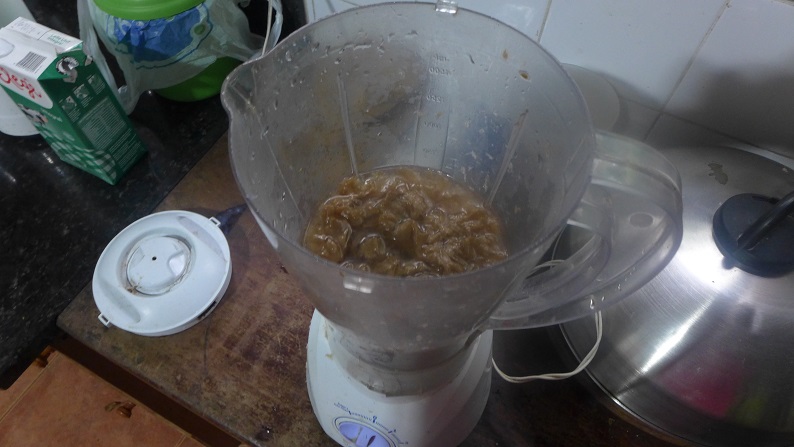 Blender.jpg
(Filesize: 111KB)
Blender.jpg
(Filesize: 111KB)
-
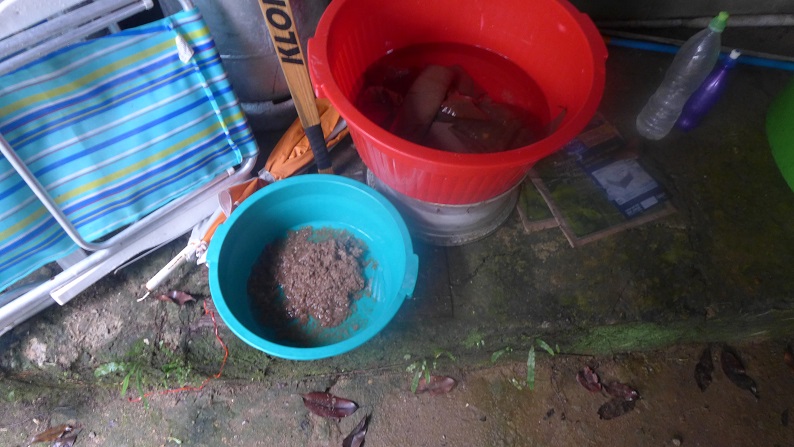 CardboardPulp.jpg
(Filesize: 145KB)
CardboardPulp.jpg
(Filesize: 145KB)
-
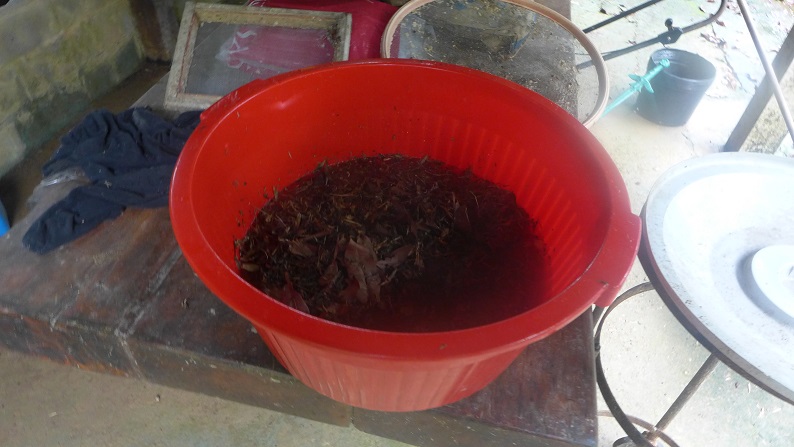 CardboardP...rass.jpg
(Filesize: 120KB)
CardboardP...rass.jpg
(Filesize: 120KB)
-
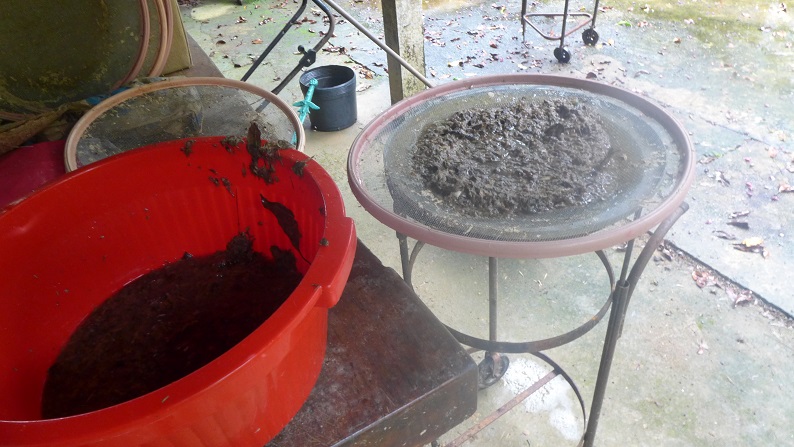 MixturePla...ieve.jpg
(Filesize: 155KB)
MixturePla...ieve.jpg
(Filesize: 155KB)
-
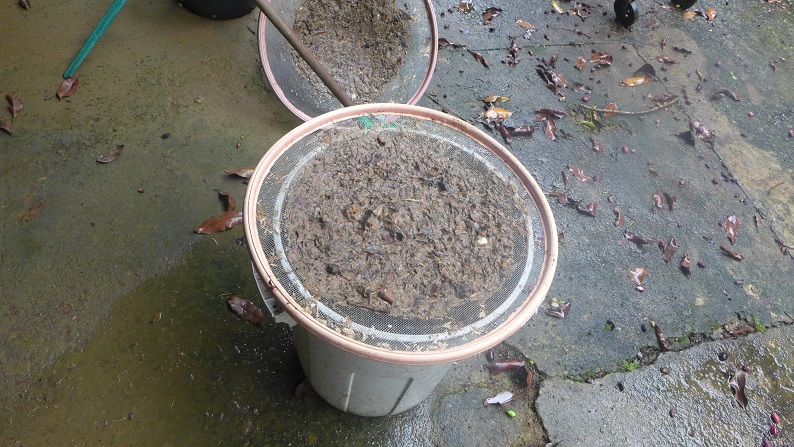 MixtureonS...ater.jpg
(Filesize: 206KB)
MixtureonS...ater.jpg
(Filesize: 206KB)
-
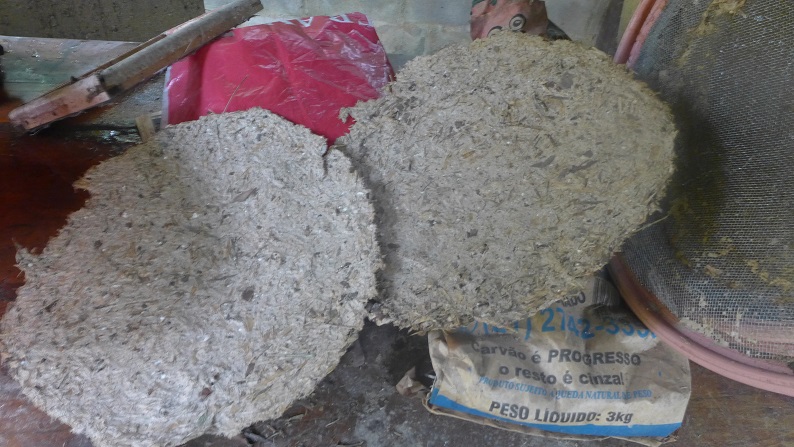 ClamShells.jpg
(Filesize: 171KB)
ClamShells.jpg
(Filesize: 171KB)
-
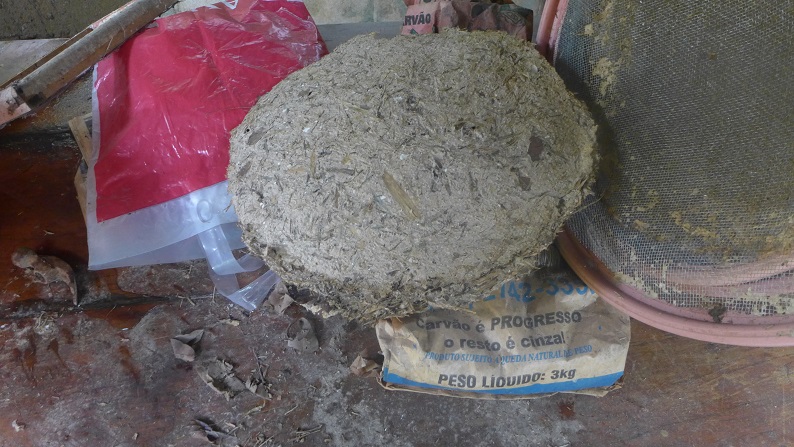 EmptyClam.jpg
(Filesize: 183KB)
EmptyClam.jpg
(Filesize: 183KB)
The following user(s) like this post: Mona
Please Log in to join the conversation.
You need to login to reply- Billy
-
 Topic Author
Topic Author- interested in productive sanitation
Less- Posts: 9
- Karma: 2
- Likes received: 2
Thank you Mona, as long as the waste is not more humid than a firm stool, the clam can hold feces for a long time. The ratio I have not worked out but the idea is to have all the grass clippings bound together by the cardboard pulp. I shall do a photo session and post soonest. Just to be clear, the photos shall be of the making of the clam, not the using! I think the concept could fit in nicely with your product with the pissibility that the clam shells could be made locally by people who could have need for some extra income.
Don't throw it all away!
The following user(s) like this post: Mona
Please Log in to join the conversation.
You need to login to reply
Dear Billy,
Thanks for sharing and welcome to SuSanA forum! The chamber pot recipe sounds great. I'm very curious to know more, since I started in February to research on the same idea. I found a company that produces cellulose bowls for hospital toilets. The bowls are from recycled paper and are supposed to be water-tight at least for 4h. See their website: www.ecopatent.net/Bowl-for-Toilet-Seat-NT-CB-1/ (for some reason there are many more products shown on their German website, just change the language to see more)
Very interesting are the disposable urinals for men and women that are also made from cellulose and keep up to 1,5 liters of urine. The bowls and urinals are disposed into a machine (macerator) that defibrates and liquefies it. The sludge is disposed into the sewerage system.
Im experimenting with the bowls right now and would like to know more about your version.
- how long does your chamber hold the waste without leaking?
- how is the ratio, cardboard to grass clippings?
- could you post a picture?
Thanks in advance!
Mona
here a picture of the test with home-made fake-poop!
Thanks for sharing and welcome to SuSanA forum! The chamber pot recipe sounds great. I'm very curious to know more, since I started in February to research on the same idea. I found a company that produces cellulose bowls for hospital toilets. The bowls are from recycled paper and are supposed to be water-tight at least for 4h. See their website: www.ecopatent.net/Bowl-for-Toilet-Seat-NT-CB-1/ (for some reason there are many more products shown on their German website, just change the language to see more)
Very interesting are the disposable urinals for men and women that are also made from cellulose and keep up to 1,5 liters of urine. The bowls and urinals are disposed into a machine (macerator) that defibrates and liquefies it. The sludge is disposed into the sewerage system.
Im experimenting with the bowls right now and would like to know more about your version.
- how long does your chamber hold the waste without leaking?
- how is the ratio, cardboard to grass clippings?
- could you post a picture?
Thanks in advance!
Mona
here a picture of the test with home-made fake-poop!
MoSan - Mobile Sanitation
is.gd/mobilesanitation
is.gd/mobilesanitation
Attachments:
-
IMG_0531.JPG (Filesize: 25KB)
The following user(s) like this post: Billy
Please Log in to join the conversation.
You need to login to reply- Billy
-
 Topic Author
Topic Author- interested in productive sanitation
Less- Posts: 9
- Karma: 2
- Likes received: 2
Chris, thanks for your kind message! I am in Rio de Janeiro, born here of British parents. Live in the sticks, not unlike where the photo you posted. Absolutely no background or training in ecosan, just got interested through composting and reading the humanure handbook and sometimes I wonder what the heck I am doing squatting over a crazy tray in the backyard! The clam... It was originally just meant to be a compostable recipient for kitchen scraps, then it became a scoop for doggy poop and evolved into the clam for containment of human feces, much like a manure pack... The composting of the disintegrated clam should be thermophilic and that might well kill off pathogens... The compost heap, once full, is left for a year, and that should deal with the sanitization. Much like putting a full jute bag aside for a year and a bit...with the added benefit of having it composted (thermophilic) first. The clam is labour intensive and this would be much reduced on a large scale... However losing the descentralized aspect. I like your portable male/female urinal and see it as a means of filling a jerry can for storage and collection purposes. But then, who is going to want to store their excrement and whois going to want to collect it? Only somebody who knows its value! And it only has value if given value, which means that it doesn't quite fit in with the present economic / legislative system. Only a system of humility, servitude and care could make it (collection of excrement to use as fertilizer) work and reap the rewards that could and definitely would be forthcoming, which, should be for all who participate in the venture.
Don't throw it all away!
Please Log in to join the conversation.
You need to login to reply
Hi Billy,
Welcome to the Forum and thanks for sharing the Compostable Clam. I agree that we should creatively look for simple solutions, but I think the making of these Clams is too labor-intensive (which could be solved via mass production if this is taken to a big scale).
I show a solution for dealing with the urine while filling your clams in this simpler and even more minimalist toilet design:
inodoroseco.blogspot.com/2013/10/a-free-...ist-uddt-part-1.html
in the form of this portable urinal made with two plastic bottles
inodoroseco.blogspot.com/2013/05/urinarios-ecologicos.html
It would be good to be more careful about the times, temperatures, and containment of the composting process, to make sure that potential pathogens get destroyed.
What part of Brazil are you in? Is it hot and tropical or are you in the Southeast? Your English is very good. Are you originally from Brazil or elsewhere? What are your training and background in?
Best wishes,
Chris Canaday
Welcome to the Forum and thanks for sharing the Compostable Clam. I agree that we should creatively look for simple solutions, but I think the making of these Clams is too labor-intensive (which could be solved via mass production if this is taken to a big scale).
I show a solution for dealing with the urine while filling your clams in this simpler and even more minimalist toilet design:
inodoroseco.blogspot.com/2013/10/a-free-...ist-uddt-part-1.html
in the form of this portable urinal made with two plastic bottles
inodoroseco.blogspot.com/2013/05/urinarios-ecologicos.html
It would be good to be more careful about the times, temperatures, and containment of the composting process, to make sure that potential pathogens get destroyed.
What part of Brazil are you in? Is it hot and tropical or are you in the Southeast? Your English is very good. Are you originally from Brazil or elsewhere? What are your training and background in?
Best wishes,
Chris Canaday
Conservation Biologist and EcoSan Promoter
Omaere Ethnobotanical Park
Puyo, Pastaza, Ecuador, South America
inodoroseco.blogspot.com
Omaere Ethnobotanical Park
Puyo, Pastaza, Ecuador, South America
inodoroseco.blogspot.com
Attachments:
-
 UrinarioEcologico.jpg
(Filesize: 47KB)
UrinarioEcologico.jpg
(Filesize: 47KB)
The following user(s) like this post: Carol McCreary, Billy
Please Log in to join the conversation.
You need to login to reply- Billy
-
 Topic Author
Topic Author- interested in productive sanitation
Less- Posts: 9
- Karma: 2
- Likes received: 2
As this is my first post, a brief introduction follows.
I am not a scientist. My concern as to the destination of human waste is relatively recent. I am 57, married and we have a large family and live in Brazil. We use a flush toilet at home, although I secretly squat outdoors onto a mat of garden clippings placed on a tray, which then gets mixed with kitchen waste and placed inside a compost heap, following the Joe Jenkins humanure method.
I have been experimenting trying to devise how to collect and temporary store kitchen waste. My experiments lead me to the compostable clam, a chamber pot for feces only. The compostable clam is better than a mat of grass and leaves because it reduces the chance of getting bitten by ticks.
Anyway, here’s how to make the compostable clam, a method that recycles cardboard and grass clipping to make a biodegradable chamber pot for feces.
The saucer can be used as a chamber pot, but only for firm feces. Urine shall have to somehow find its way into a jerry can. Diarrhea shall require further study!
Once squatted over, the deposit can be covered by another saucer forming a clam, the contents of which shall be the bonding material.
This self sealing clam can be placed in a dry, critter proof recipient for collection at a convenient time.
Collected clams can be disintegrated using collected urine and the result either composted or placed directly in troughs dug in the field and covered with at least 5cm of earth.
The dry clams are not obnoxious and neither is urine in a jerry can. The mixture of the two definitely is!
The dry clams could, theoretically, be buried under 5cm of earth and the earth then watered using the separately collected urine, which would be less obnoxious. I have disintegrated clams in the compost heap using water. It wasn’t too horrible.
Theoretically, grass seeds could be placed in the pulp and grass mixture such that should the clams be placed on a field, grass would sprout! Theoretically, clam halves could be used to cover open air deposits. Heavy rain showers would be a problem though.
The benefits are that people would be able to relieve themselves in the privacy of their rooms, the feces retains its nutritional values and becomes easily transportable for collection.
The clam halves can be made by anybody with a blender, access to sun, used cardboard and grass clipping, a couple of sifters or more, a basin and a bin and some time.
I rather like the idea. It is cheap and makes for easy storage and collection and application. People could be paid for their excrement and thus start to give it value. Well treated it would treat us well. Mistreated we get shit (famine and disease). Well treated we get wealth (health and food). As my mother would say “waste not, want not”.
I am not a scientist. My concern as to the destination of human waste is relatively recent. I am 57, married and we have a large family and live in Brazil. We use a flush toilet at home, although I secretly squat outdoors onto a mat of garden clippings placed on a tray, which then gets mixed with kitchen waste and placed inside a compost heap, following the Joe Jenkins humanure method.
I have been experimenting trying to devise how to collect and temporary store kitchen waste. My experiments lead me to the compostable clam, a chamber pot for feces only. The compostable clam is better than a mat of grass and leaves because it reduces the chance of getting bitten by ticks.
Anyway, here’s how to make the compostable clam, a method that recycles cardboard and grass clipping to make a biodegradable chamber pot for feces.
- Dampen the cardboard enough to allow for the peeling off of a layer of paper with any coloured print on it.
- Allow the cardboard without print on it to soak in water for a couple of days, tearing it into small pieces.
- Pass the soaked plain cardboard through a blender and pour the resulting pulp into a big basin.
- Mix in some grass clippings. Make sure the cardboard pulp and grass are well mixed together. The next steps are similar to making recycled paper.
- Using the underside of a 50 litre bin lid as a tray, place a round rice sifter in the tray and fill to the brim with water. Use a large bowl to hold the tray in place.
- Grab a couple of handfuls of the pulp and grass clipping mixture and place it in the puddle of water in the sifter on the flooded upturned lid and spread it about evenly.
- Raise the sifter and place it over the top of the empty open bin.
- Press down on the mixture using another sifter in order to take out excess water.
- Place the sifter with the evenly spread, pressed mixture in the sun to dry.
The saucer can be used as a chamber pot, but only for firm feces. Urine shall have to somehow find its way into a jerry can. Diarrhea shall require further study!
Once squatted over, the deposit can be covered by another saucer forming a clam, the contents of which shall be the bonding material.
This self sealing clam can be placed in a dry, critter proof recipient for collection at a convenient time.
Collected clams can be disintegrated using collected urine and the result either composted or placed directly in troughs dug in the field and covered with at least 5cm of earth.
The dry clams are not obnoxious and neither is urine in a jerry can. The mixture of the two definitely is!
The dry clams could, theoretically, be buried under 5cm of earth and the earth then watered using the separately collected urine, which would be less obnoxious. I have disintegrated clams in the compost heap using water. It wasn’t too horrible.
Theoretically, grass seeds could be placed in the pulp and grass mixture such that should the clams be placed on a field, grass would sprout! Theoretically, clam halves could be used to cover open air deposits. Heavy rain showers would be a problem though.
The benefits are that people would be able to relieve themselves in the privacy of their rooms, the feces retains its nutritional values and becomes easily transportable for collection.
The clam halves can be made by anybody with a blender, access to sun, used cardboard and grass clipping, a couple of sifters or more, a basin and a bin and some time.
I rather like the idea. It is cheap and makes for easy storage and collection and application. People could be paid for their excrement and thus start to give it value. Well treated it would treat us well. Mistreated we get shit (famine and disease). Well treated we get wealth (health and food). As my mother would say “waste not, want not”.
Don't throw it all away!
Please Log in to join the conversation.
You need to login to reply
Share this thread:
- Forum
- categories
- Sanitation systems
- Toilets without urine diversion
- Container-based, mobile or bag-based toilets
- The Clam - A compostable chamber pot.
Recently active users. Who else has been active?
Time to create page: 0.184 seconds








